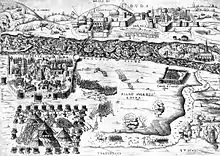| Siege of Pest | |||||||
|---|---|---|---|---|---|---|---|
| Part of the Ottoman–Habsburg wars | |||||||
 Siege of Pest, after Enea Vico, 1542 | |||||||
| |||||||
| Belligerents | |||||||
|
|
| ||||||
| Commanders and leaders | |||||||
| Suleiman the Magnificent |
Alessandro Vitelli Hans von Ungnad Nikola IV Zrinski | ||||||
| Strength | |||||||
| 2,000 Janissaries, 10,000 Sipahi and irregular troops | ~60,000 soldiers, 60 guns | ||||||
| Casualties and losses | |||||||
| unknown | heavy | ||||||
The siege of Pest (modern city of Budapest, Hungary) occurred in 1542, when Ferdinand I attempted to recover the cities of Buda and Pest in 1542 from the Ottoman Empire.[1] They had been occupied by the Ottomans under Suleiman since the siege of Buda (1541).[2]
The siege was led by Joachim of Brandenburg.[2] The siege was repulsed by the Ottomans, who would remain in control of central Hungary for the following 150 years.
Notes
- ↑ E.J. Brill's first encyclopaedia of Islam, 1913–1936, Vol 2 by Martijn Theodoor Houtsma p.524
- 1 2 Anett Puskár, "Noble Strategies for Maintaining Power: Reflections on the Life of a Hungarian Aristocrat", in Power and Culture: Identity, Ideology, Representation, edited by Jonathan Osmond and Ausma Cimdin̦a (Edizioni Plus, 2007), p. 20.
This article is issued from Wikipedia. The text is licensed under Creative Commons - Attribution - Sharealike. Additional terms may apply for the media files.